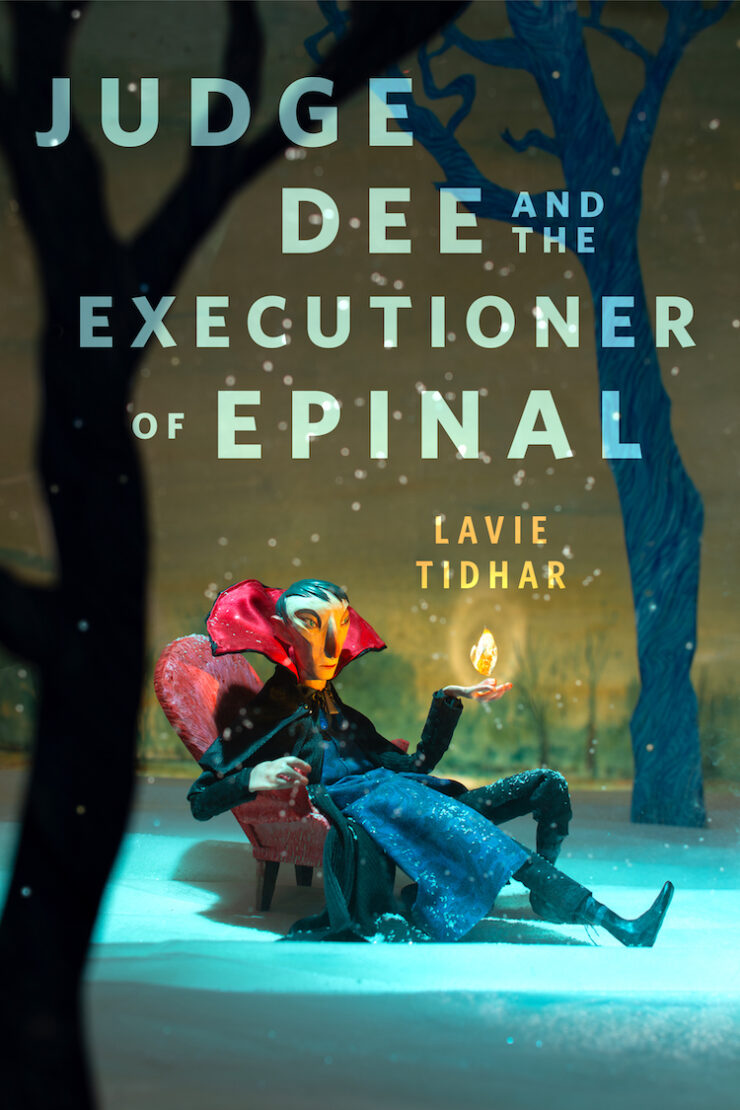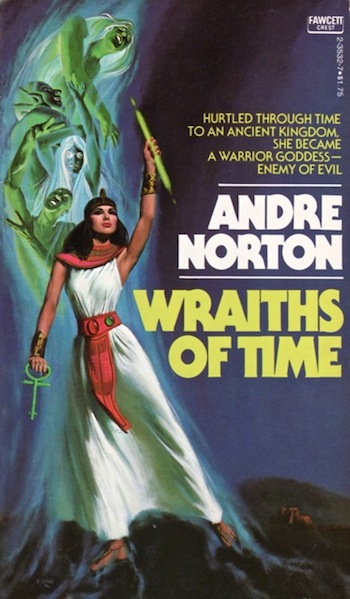There’s a whole universe of fiction and highly creative nonfiction constructed around the rediscovery of ancient Egypt. The Curse of the Pharaohs! Ancient Egyptian magic and sorcery! Mummies and pyramids and hieroglyphs, oh my!
Andre Norton generally wrote in her own worlds. She often paid tribute to her antecedents, but she tended to weave her tales either away from Earth (in space or time, or in alternate universes) or in a fantastical present. It’s rather rare for her to tackle history (or prehistory), and when she does, she still puts her own spin on it.
I can see why bibliographies of Norton works would pair Wraiths of Time (1976) with Android at Arms (1971). Both were published in the Seventies. Both feature protagonists of African ancestry, and both are portal—I won’t say fantasies. They’re more science-fictional. Portal adventures, with ancient rituals and psychic powers.
Wraiths of Time begins in the U.S. in the present day, and at first it’s a Mysteries at the Museum story. Brilliant young academic Tallahassee Mitford, with her FBI-agent cousin, is called in to secure an artifact of mysterious provenance and even more mysterious powers. She quickly discovers that there are in fact two artifacts, and she has an inexplicable connection to them both. And someone, or something, is after them.
In quite short order, Tallahassee and the artifacts are swept through a portal into an alternate world in which the ancient kingdom of Meroe provided sanctuary to the last of the Egyptian Pharaohs and grew into a multi-thousand-year empire. Europe (and white supremacy) never gained a foothold, and there was no Muhammad and therefore no rise of Islam.
Like Andas in Android at Arms, Tallahassee turns out to be our universe’s incarnation of a royal heir, in this case the Princess Ashake, heir to her sister, the Candace or Queen-Empress of Amun. Ashake is at the center of a complicated web of plots, and has been killed by the time Tallahassee arrives, but the priestess Jayta and the General Herihor (the latter a double of Cousin Jason) quickly recruit Tallahassee to play the role of Ashake. This includes a psychic/mechanical procedure that imbues Tallahassee with a significant proportion of Ashake’s memories, as well as the local language and customs.
But not, be it noted, all of them. These gaps provide convenient plot-friction and leave Tallahassee with room to improvise, either voluntarily or out of necessity.
Amun is in a terrible mess. The heir is dead (but only Tallahassee, Jayta, and Herihor know this). The Candace is missing. There’s a palace coup in the making: a male cousin, Userkof, is moving to claim the throne, incited by his part-barbarian wife and a mysterious person of unknown origins, whose name is Khasti.
Khasti has been trying to get control of the powerful artifacts that brought Tallahassee to Amun: the Rod and the Key. But only one of the royal family can even touch them, let alone wield them—which reduces the field to the missing Candace, Ashake—and her double, Tallahassee—and presumably Userkof.
That presumption proves incorrect, as Userkof’s wife discovers when she abducts Tallahassee and the artifacts and tries to get him to take possession. Then Khasti steps in.
Khasti, it turns out, is from yet another parallel world, and he wants to be king. People from his own world are trying to capture him and take him back home, but are constrained by rules that forbid them to interfere in other worlds. The best they can do is try to enlist Tallahassee/Ashake and her allies to help them.
And then there are the wraiths of the title: a number of ectoplasmic entities who were once human, whom Khasti caused to discorporate in the course of trying to master the artifacts and take over Amun. These are powerful spirits, and they are not happy. Tallahassee manages to form a sort of alliance with them.
And then there are the ancient aliens. The royals of Amun, and before them of Egypt, are descended from people who were not of Earth, preserving powers and technologies beyond those of this planet.
It all wraps up in the end, in typical, rapid-fire Norton fashion. The Candace reappears, Khasti and the palace coup are vanquished, and Tallahassee discovers that she can’t go home again. But that’s all right, she decides in the last couple of sentences. There’s nobody there she cares about anyway (completely erasing her cousin Jason, her job, and anyone else who might have mattered to her). Amun needs her; she’s the only heir, and the only one besides the Candace who can handle the Rod and the Key. She’ll stay, and take Ashake’s place.
There are some interesting developments here, for the Norton canon. The all-male universe of Fifties Norton is gone. Norton has found feminism. Tallahassee is a liberated mid-Seventies woman, and Amun is a matriarchal state, descended from the female rulers of Meroe. The soldiers of the empire are both male and female; the latter made me think of the Dora Milaje, with their combination of independent thoughts and feelings and complete devotion to the empire and its ruler.
Of course the rest of the world, or worlds, is not so enlightened. White barbarians are misogynists and male supremacists, and Khasti is a straight-up male chauvinist pig. And then there’s the consciously beautiful and perfectly evil Nasty Girl who tries to rule through the weak, fat, dimwitted, thick-lipped Userkof.
That’s a somewhat problematical undertone that we see here as in other Norton novels. Fat people are evil, and ugliness of both body and spirit manifests as blunt features and thick, loose lips. I doubt she realized the subtle racism there, or realized what she did in referring to Meroe as Egypt’s “lesser, darker sister.”
But she was trying very hard, and mostly, for 1976, she succeeded. It wasn’t her fault that the cover severely whitewashed her protagonist. She wrote Tallahassee as a proud Black woman (albeit with a little more of the Angry part than maybe was necessary) excelling in her academic field and facing difficult and improbable adventures with courage and ingenuity.
Science fiction by that time was much more feminist and non-white than it had been; Norton wasn’t quite so radical as she was in earlier decades. But it’s still notable that she made a point of writing about these characters in this setting, and doing her best to do them justice.
I’ll read Ice Crown next. This, be it noted, is one of the few Norton novels that hasn’t received the ebook treatment, but it’s pretty easily available through the used-book vendors.
Judith Tarr’s first novel, The Isle of Glass, appeared in 1985. Her most recent novel, Dragons in the Earth, a contemporary fantasy set in Arizona, was published by Book View Cafe. In between, she’s written historicals and historical fantasies and epic fantasies and space operas, some of which have been published as ebooks from Book View Café and Canelo Press. She has won the Crawford Award, and been a finalist for the World Fantasy Award and the Locus Award. She lives in Arizona with an assortment of cats, a blue-eyed dog, and a herd of Lipizzan horses.










